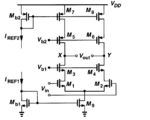han6716914
Newbie level 3

Lets say, a fully differential nmos-input telescopic amplifier, and I assume the supply is 3V, and the overdrive voltage of the M9, and M1, M3, M5, M7 is 0.5V, 0.2V,0.2V, 0.3V, 0.3V. that means the ouput swing is 1.5V for one side. and the threshold voltage for P/NMOS is 0.7V.
I want to calculate the ICMR of the OTA, I know the equation that
Vod9 + Vgs1 <= Vicm <= Voutmin - Vod3 + Vth1
and since Vod9 = 0.5V, Vgs1 = Vod1 + Vth1 = 0.2 + 0.7=0.9V, and then
1.4v <= Vicm,
but for the other half, how do I determin Voutmin ? if the Voutmin = Vod9 + Vod1 + Vod3 = 0.5 +0.2 +0.2= 0.9V, and then Vicm <= Voutmin -Vod3 + Vth1 = 0.9 - 0.2 +0.7=1.4V.
in all I get, 1.4V <= Vicm <=1.4V, isnt this weird ?
I need some help to clarify this for me. Thanks.